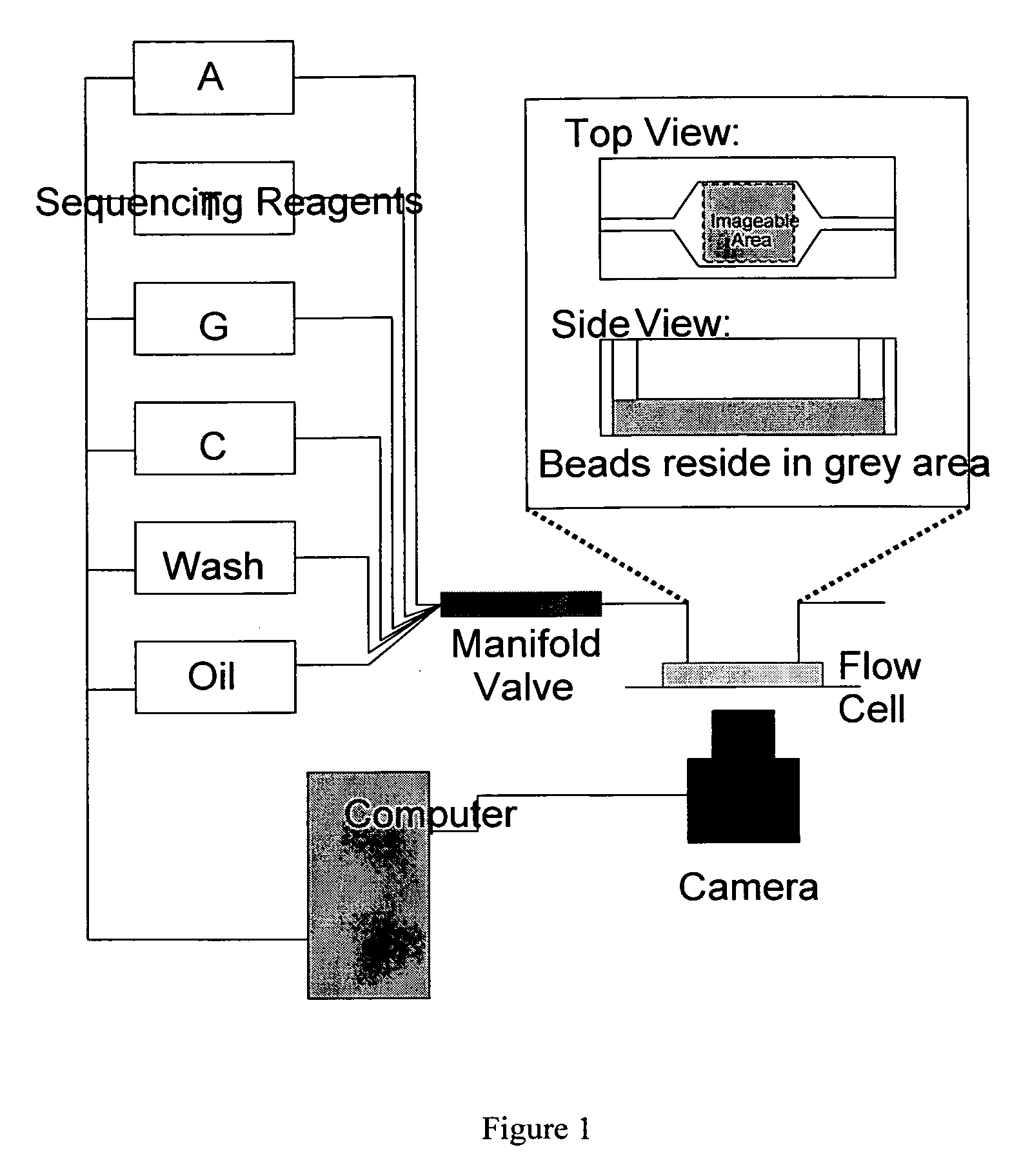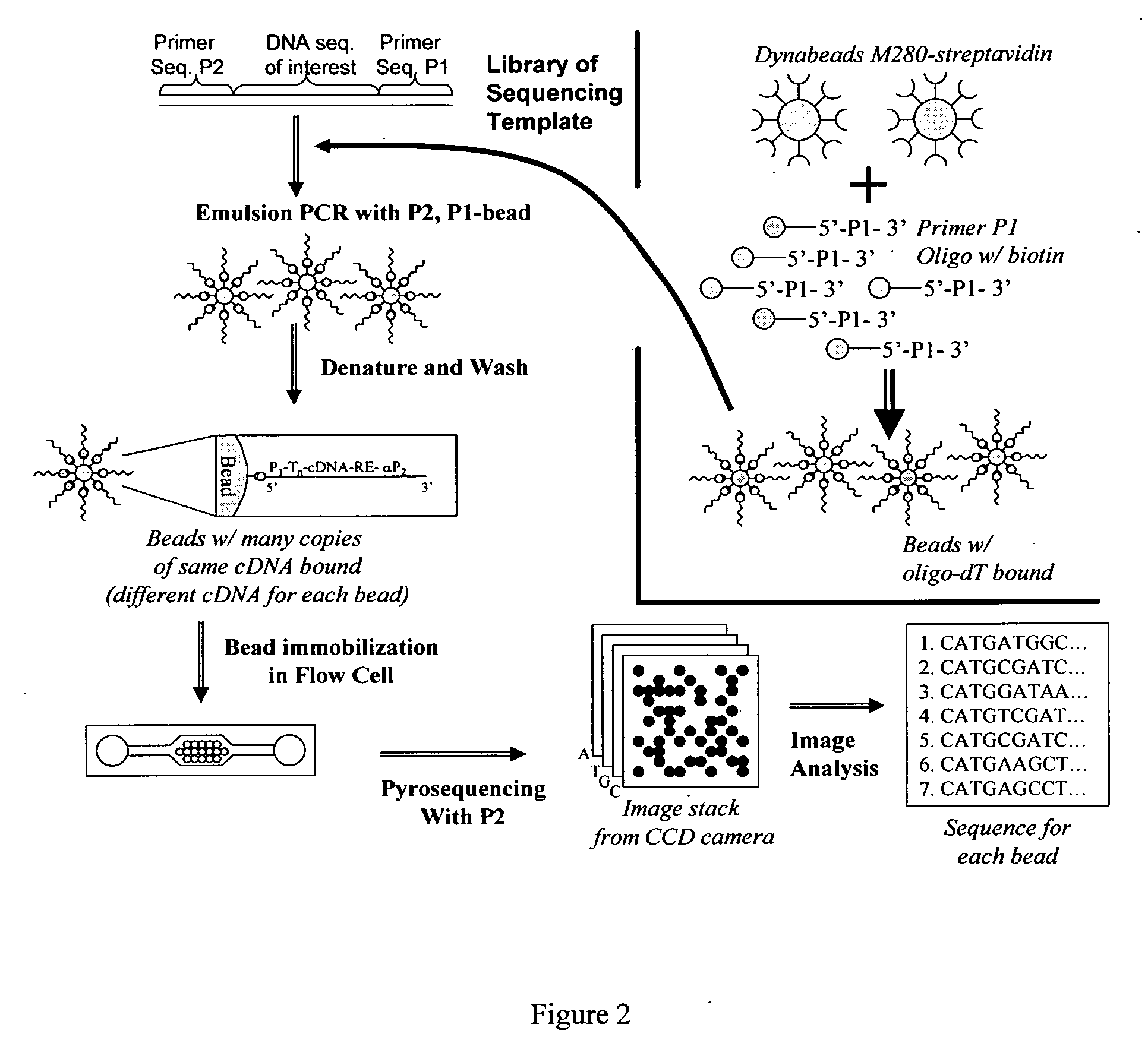High throughput DNA sequencing method and apparatus
a dna sequencing and high throughput technology, applied in specific use bioreactors/fermenters, laboratory glassware, biomass after-treatment, etc., can solve the problems of limiting the potential for global gene expression datasets, difficult comparisons between laboratories, inconsistent microarray data, etc., and achieve high throughput sequencing
- Summary
- Abstract
- Description
- Claims
- Application Information
AI Technical Summary
Benefits of technology
Problems solved by technology
Method used
Image
Examples
example 1
[0108]A cDNA molecule is created from each mRNA with a specific primer (P1) attached to the 5′ end via reverse transcription (Superscript III) (Invitrogen, Carlsbad, Calif.) using oligo-dT with primer P1 attached to the 5′ end. Each cDNA is converted into a double stranded DNA (dsDNA) using the Gubler-Hoffman Second Strand Synthesis method (DNA Ligase, RNAse H, T4 Polymerase, DNA Polymerase I) (Invitrogen). Each cDNA is cut with a restriction enzyme so that there is a 5′ overhang with known sequence, e.g., FatI, which leaves a 5′ overhang of CATG. Each dsDNA is ligated with a complementary oligo with a 5′ overhang of CATG connected to a primer P2 (see FIG. 1). Primer P2 is not phosphorylated, so the resultant product can not concatemerize. Adding adapter P2 in excess concentration minimizes cDNA chimera formation. This yields dsDNA molecules that are flanked with primers P1 and P2 on the 5′ ends.
example 2
Bead Synthesis and Emulsion PCR
[0109]The PCR product must be attached to some solid substrate to maintain physical locality when the sequencing template is removed from the emulsion. One approach provides beads coated with the 3′ primer sequence P1 (see FIG. 2) such that the PCR product is bound to the bead. After the PCR reaction, the beads can be isolated and prepared for sequencing.
[0110]Briefly, beads coated with bound primer P1 are synthesized by mixing super magnetic beads coated with covalently bound streptavidin (Dynabeads M-280 or MyOne C1 or M450 tosyl activated with subsequent streptavidin incorporation) with P1 oligos modified on the 5′ end with dual biotin groups separated by a six-carbon linker with a spacer arm (to reduce steric hindrance and allow the oligonucleotides to be cleaved). After binding has occurred, the beads are washed thoroughly to remove unbound oligonucleotides. Oligonucleotides with a single biotin group may dissociate from the beads when the tempera...
example 3
Bead Immobilization
[0115]As noted previously, it is desirable to immobilize the beads to the imagable surface such that they do not move when reagents flow over them. If the beads move, it will be impossible to register the sequential images and determine the sequence of nucleic acid on each bead. Beads can be immobilized to the slide in a number of ways. One method of immobilizing beads is streptavidin-biotin binding of the beads to a biotinylated protein and covalent binding of carboxyl groups and amine groups of the protein to glass via silation of the glass with a reactive group containing silane (such as 3-Aminopropyltriethoxysilane (APTES)). A second method is silanization of glass with APTES but modification of the 3′ end of the DNA on the bead by ligation with a nucleotide containing a 3′ primary amine group and covalent bonding to the slide through amine-ester bonds.
[0116]These procedures provide a dense monolayer coating of beads. Also, the non-uniform layout of the beads ...
PUM
| Property | Measurement | Unit |
|---|---|---|
| Length | aaaaa | aaaaa |
| Fraction | aaaaa | aaaaa |
| Time | aaaaa | aaaaa |
Abstract
Description
Claims
Application Information
 Login to View More
Login to View More - R&D
- Intellectual Property
- Life Sciences
- Materials
- Tech Scout
- Unparalleled Data Quality
- Higher Quality Content
- 60% Fewer Hallucinations
Browse by: Latest US Patents, China's latest patents, Technical Efficacy Thesaurus, Application Domain, Technology Topic, Popular Technical Reports.
© 2025 PatSnap. All rights reserved.Legal|Privacy policy|Modern Slavery Act Transparency Statement|Sitemap|About US| Contact US: help@patsnap.com



